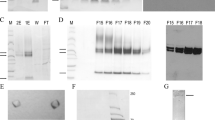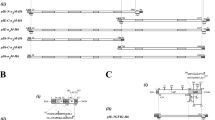Abstract
Polypeptides classified as transforming growth factors (TGFs) have been found in various neoplastic cells and tumour tissues1–5, and most recently in many non-neoplastic tissues6. These TGFs are low-molecular-weight (7,000–20,000) acid-stable polypeptides, which induce anchorage-dependent non-neoplastic indicator cells to form progressively growing colonies in soft agar. Certain extracellular TGFs isolated from conditioned medium derived from both rodent sarcoma virus-transformed cells and several human tumour cell lines have been shown to compete with epidermal growth factor (EGF) for membrane receptors1,3,4,7. By direct extraction from Moloney sarcoma virus (MSV)-transformed cells, we have isolated two distinct classes of intracellular TGFs, one of which competes with EGF for receptor binding sites, whereas the other does not. We report here that after purification by HPLC, the colony-forming activity of the TGFs that do not compete with EGF for receptor binding was enhanced 100-fold by the addition of EGF. This ability to enhance the growth-stimulating effects of the TGFs is specific to EGF, as insulin, the insulin-like growth factors, platelet-derived growth factor and nerve growth factor do not show this property. In contrast, the colony-forming activity of TGFs that compete with EGF for receptor binding is not potentiated by EGF.
This is a preview of subscription content, access via your institution
Access options
Subscribe to this journal
Receive 51 print issues and online access
$199.00 per year
only $3.90 per issue
Buy this article
- Purchase on Springer Link
- Instant access to full article PDF
Prices may be subject to local taxes which are calculated during checkout
Similar content being viewed by others
References
De Larco, J. E. & Todaro, G. J. Proc. natn. Acad. Sci. U.S.A. 75, 4001–4005 (1978).
Roberts, A. B. et al. Proc. natn. Acad. Sci. U.S.A. 77, 3494–3498 (1980).
Todaro, G. J., Fryling, C. & De Larco, J. E. Proc. natn. Acad. Sci. U.S.A. 77, 5258–5262 (1980).
Ozanne, B., Fulton, R. J. & Kaplan, P. L. J. cell. Physiol. 105, 163–180 (1980).
Moses, H. L., Branum, E. L., Proper, J. A. & Robinson, R. A. Cancer Res. 41, 2842–2848 (1981).
Roberts, A. B., Anzano, M. A., Lamb, L. C., Smith, J. M. & Sporn, M. B. Proc. natn. Acad. Sci. U.S.A. 78, 5339–5343 (1981).
De Larco, J. E. & Todaro, G. J. J. cell. Physiol. 102, 267–277 (1980).
De Larco, J. E. & Todaro, G. J. J. cell. Physiol. 94, 335–342 (1978).
Topp, W. C., Rifkin, D., Graessmann, A., Chang, C. M. & Sleigh, M. J. Cold Spring Harb. Conf. Cell Proliferation Vol. 6 (eds Sato, G. H. & Ross, R.) 361–370 (1979).
Wrann, M., Fox, C. F. & Ross, R. Science 210, 1363–1365 (1980).
Shoyab, M., De Larco, J. E. & Todaro, G. J. Nature 279, 387–391 (1979).
Magun, B. E., Matrisian, L. M. & Bowden, G. T. J. biol. Chem. 255, 6373–6381 (1980).
Rozengurt, E., Brown, K. D. & Pettican, P. J. biol. Chem. 256, 716–722 (1981).
Johnson, L. K., Baxter, J. D., Vlodavsky, I. & Gospodarowicz, D. Proc. natn. Acad. Sci. U.S.A. 77, 394–398 (1980).
Kahn, P. & Shin, S. J. Cell Biol. 82, 1–16 (1979).
Cifone, M. A. & Fidler, I. J. Proc. natn. Acad. Sci. U.S.A. 77, 1039–1043 (1980).
Harrison, J. & Auersperg, N. Science 213, 218–219 (1981).
Seif, R. J. Virol. 36, 421–428 (1980).
Rose, S. P., Stahn, R., Passovoy, D. S. & Herschman, H. Experientia 32, 913–915 (1976).
Fisher, P. B., Bozzone, J. H. & Weinstein, I. B. Cell 18, 695–705 (1979).
Roberts, A. B., Anzano, M. A., Frolik, C. A. & Sporn, M. B. Cold Spring Harb. Conf. Cell Proliferation (in the press).
Hollenberg, M. D. Vitam. Horm. 37, 69–110 (1979).
Sporn, M. B., Newton, D. L., Roberts, A. B., De Larco, J. E. & Todaro, G. J. in Molecular Actions and Targets for Cancer Chemotherapeutic Agents (eds Sartorelli, A. C., Bertino, J. R. & Lazo, J. S.) 541–554 (Academic, New York, 1981).
Savage, C. R. & Cohen, S. J. biol. Chem. 247, 7609–7611 (1972).
Author information
Authors and Affiliations
Rights and permissions
About this article
Cite this article
Roberts, A., Anzano, M., Lamb, L. et al. Isolation from murine sarcoma cells of novel transforming growth factors potentiated by EGF. Nature 295, 417–419 (1982). https://doi.org/10.1038/295417a0
Received:
Accepted:
Issue Date:
DOI: https://doi.org/10.1038/295417a0
This article is cited by
-
Animal models of scarring control
Eye (2020)
-
In vitro bioassay for transforming growth factor-β using XTT method
Archives of Pharmacal Research (2002)
-
Growth factor interactions between mouse mammary cell lines cocultured in collagen gels
In Vitro Cellular & Developmental Biology (1989)
-
Transforming growth factor-�s as modulators of pericellular proteolytic events
Cytotechnology (1989)
Comments
By submitting a comment you agree to abide by our Terms and Community Guidelines. If you find something abusive or that does not comply with our terms or guidelines please flag it as inappropriate.



